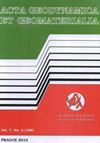Application of rock mass classification to evaluate rock properties, NW Himalayas, Pakistan
IF 0.8
4区 地球科学
Q4 GEOCHEMISTRY & GEOPHYSICS
引用次数: 2
Abstract
The rock units of the NW Himalayan region are fragile, heavily fractured and highly deformed due to active tectonics and complex geological setup. Fast urbanization, road constructions along hill slopes and other infrastructural development activities also increased the slopes instability problems. The present study emphasizes the application of rock mass classification to estimate the rock mass properties along the Yadgar section Muzaffarabad, NW Himalayas, Pakistan. For this purpose, Rock Mass Rating (RMR) and Geological Strength Index (GSI) were used to characterize and classify the rock masses. In the present study, twenty-five sites have been investigated to evaluate rock properties along the Muzaffarabad-Neelum road, Sub-Himalayas, Pakistan. Result of the study shows that the Abbottabad Formation of Cambrian age is vulnerable in the Yadgar section with extremely poor RQD (Rock Quality Designation), lowest UCS (Unconfined Compression Strength) values and closely spaced discontinuities. RMR values of the Abbottabad Formation ranges from 40-54 and classified as Poor to Fair having low GSI (20±3-35±3), blocky, disintegrated structure. The Paleocene Hangu Formation has lowest GSI (28±3-29±3; Blocky, Disturbed/ Seamy in nature) having RMR (40-45) and Eocene Kuldana Formation has GSI (30±345±3; Blocky) having RMR (34-67), are categorized as heavily broken, disintegrated and poorly interlocked rock masses. RMR values of rock units of the Paleocene Lockhart Formation (52-60), the Miocene Murree Formation (38-63), and the Eocene Margala Hill Limestone (38-61) are relatively higher values of GSI ranges from (35±3-45±3; 35±3-50±3; 30±3-40±3) respectively. RMR and GSI values in Yadgar section, ranges between 34-67 and 20±3-50±3 respectively. Analysis shows positive correlation between GSI and RMR values. This approach to evaluate the rock mass classification through RMR and GSI will give the better estimation of rock mass properties along Muzaffarabad-Neelum road to identify the vulnerable slopes and design effective geotechnical measures. ARTICLE INFO岩体分类在巴基斯坦喜马拉雅山脉西北部岩石性质评价中的应用
受活动构造和复杂地质构造的影响,西北喜马拉雅地区岩石单元脆弱、断裂严重、变形严重。快速城市化、沿坡道路建设和其他基础设施开发活动也增加了边坡不稳定问题。本文着重介绍了岩体分类方法在巴基斯坦西北喜马拉雅山脉穆扎法拉巴德亚德加尔剖面岩体性质评价中的应用。为此,采用岩体等级(RMR)和地质强度指数(GSI)对岩体进行表征和分类。在本研究中,研究人员对巴基斯坦亚喜马拉雅山脉穆扎法拉巴德-尼勒姆公路沿线的25个地点进行了调查,以评估岩石特性。研究结果表明,Yadgar剖面寒武系Abbottabad组脆弱,岩石质量指标RQD极差,无侧限抗压强度(UCS)值最低,不连续面间隔紧密。Abbottabad组RMR值在40 ~ 54之间,GSI值较低(20±3 ~ 35±3),呈块状、崩解构造。古新世汉沽组GSI最低(28±3 ~ 29±3);块状、扰动/粘稠),RMR值(40-45),始新统Kuldana组GSI值(30±345±3);具有RMR(34-67)的块状岩体,被归类为严重破碎、崩解和互锁不良的岩体。古新统Lockhart组(52 ~ 60)、中新统Murree组(38 ~ 63)和始新统Margala Hill Limestone(38 ~ 61)的RMR相对较高,GSI值为(35±3 ~ 45±3);35±3-50±3;分别30±3-40±3)。Yadgar剖面RMR值为34 ~ 67,GSI值为20±3 ~ 50±3。分析表明GSI与RMR值呈正相关。该方法通过RMR和GSI对Muzaffarabad-Neelum公路沿线的岩体分类进行评价,可以更好地估计沿线岩体的性质,从而识别脆弱边坡并设计有效的岩土工程措施。条信息
本文章由计算机程序翻译,如有差异,请以英文原文为准。
求助全文
约1分钟内获得全文
求助全文
来源期刊

Acta Geodynamica et Geomaterialia
地学-地球化学与地球物理
CiteScore
2.30
自引率
0.00%
发文量
12
期刊介绍:
Acta geodynamica et geomaterialia (AGG) has been published by the Institute of Rock Structures and Mechanics, Czech Academy of Sciences since 2004, formerly known as Acta Montana published from the beginning of sixties till 2003. Approximately 40 articles per year in four issues are published, covering observations related to central Europe and new theoretical developments and interpretations in these disciplines. It is possible to publish occasionally research articles from other regions of the world, only if they present substantial advance in methodological or theoretical development with worldwide impact. The Board of Editors is international in representation.
 求助内容:
求助内容: 应助结果提醒方式:
应助结果提醒方式:


